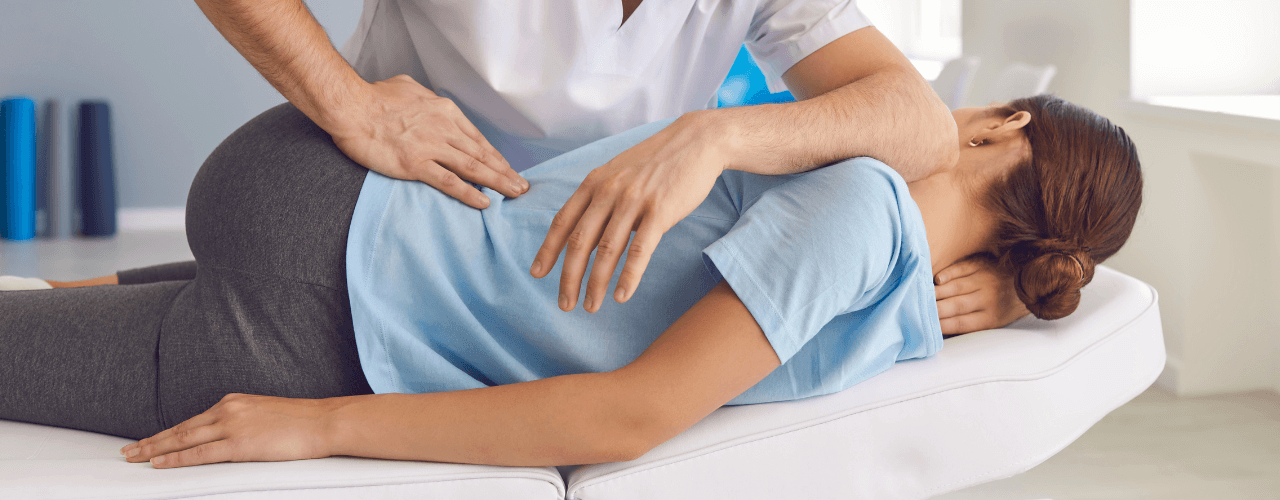Find the Relief You’ve Been Looking For!
Living with back pain can be aggravating, especially when nothing seems to be helping.
If you are concerned about your back pain symptoms, please contact our PT clinic to schedule a consultation.
It is possible that your symptoms could be the result of a herniated disc. If this is the case, a physical therapist can help you feel better and even help the damaged disc heal.
Herniated discs, explained
When the gel-like core inside a spinal disc leaks out through a small tear in the disc’s outer layer, it’s called a herniated disc.
We frequently compare it to jelly leaking from a jelly donut! When this occurs, the injured disc tissue may irritate or compress nearby spinal nerves or joint structures, resulting in pain and other symptoms.
Herniated discs are most common in men between the ages of 35 and 55, but they can happen to anyone, especially those with other herniated disc risk factors, such as:
- Sedentary behavior
- Physically demanding job and/or frequent exposure to vibration, heavy lifting, or twisting and bending
- Smoking habit
- Obesity
- Family history
Herniated discs can occur suddenly (such as a result of a car accident or other traumatic event), or they can develop gradually over time. We see them most frequently in the neck and lower back.
A herniated disc is frequently misidentified as a slipped disc. However, discs do not “slip.” They can herniate, as previously described, or “bulge” out of place.
A bulging disc occurs when something causes a disc to protrude from its normal position in the spine, but the outer layer of the disc does not tear, preventing the inner gel-like core from leaking out. However, the symptoms and treatment of a bulging disc are frequently similar to those of a herniated disc.
Common symptoms of herniated discs
Something you might be surprised to learn is that herniated discs do not always cause pain or other symptoms! Surprisingly, even if a person has no complaints, a herniated disc can be detected on an MRI.
However, if a herniated disc does cause symptoms, the problems can be extremely disruptive. The following are common symptoms of a herniated disc:
- Shooting pain and numbness in an arm or leg (if the herniated disc irritates a nearby nerve root that innervates that arm or leg)
- Weakness and altered reflexes in an arm or leg (at our physical therapy clinic, some of our patients report issues like frequent tripping because the muscles that lift the foot become weak)
- Decreased range of motion in the neck or back
- Tense and painful muscle spasms near the injured disc
- Pain that gets better with certain movements and worse with other movements (for example, herniated disc symptoms often get worse or move further into your arm or leg when you bend forward, and get better or move closer to your spine when you lean back or lay flat)
The only way to be certain about what’s causing your back pain is to see a doctor, physical therapist, or other health professional. Keep in mind that it’s not always possible to determine what’s causing your symptoms.
It’s okay though, because research shows that even when doctors are unable to provide an exact diagnosis for back pain (so-called “idiopathic” cases), physical therapy treatment can be beneficial.
What can a physical therapist do for me?
Physical therapy is regarded as the first line of defense in the treatment of herniated discs. Your physical therapist can use a variety of examination tests and techniques to help you understand what’s going on and identify any underlying factors that may have contributed to your disc herniation.
People with limited hip range of motion or weak core muscles, for example, are more likely to develop herniated discs. Identifying these types of contributing factors allows us to address them and help reduce your chances of having disc problems in the future.
Your physical therapist may also recommend the following treatments for a herniated disc:
- Manual therapy, including soft tissue massage
- Non-invasive tools like therapeutic ultrasound, electrical stimulation, biofeedback, cold and hot therapy, and diathermy to promote healing, reduce spasms and inflammation, and improve your movement
- Therapeutic exercises and stretches to improve core strength and endurance, range of motion, and posture
- Orthotics and other types of adaptive equipment like walkers or long-handled reachers to help improve skeletal alignment and make it easier to perform daily tasks
According to research, even after a herniated disc heals, a person may still experience long-term pain.
This can happen if your nervous system becomes overly sensitive in an attempt to protect you—something physical therapy can help with using a technique called therapeutic neuroscience education (TNE). We can actually help you experience less pain by helping you better understand what pain is and how it occurs!
We also provide education about proper body mechanics, ergonomics, self-pacing techniques, exercise programs, and more to our patients with herniated discs and other issues causing low back pain.
Physical therapy, according to the Centers for Disease Control and Prevention (CDC), is a good alternative to prescription opioid medications for treating low back pain caused by herniated discs and other (non-cancer) issues.
Our physical therapy team also understands that in the early stages of an injury, pain medication may be required to alleviate pain and reduce inflammation.
That is why we collaborate with your entire medical team to ensure you receive the best treatment for your specific situation. If you have any questions about your medications, please contact your prescribing physician.
Ready to start living comfortably? Contact us to get started
If you are experiencing herniated disc symptoms and want to avoid surgery or reduce your reliance on prescription pain relievers, please contact our physical therapy clinic right away.
We’re delighted to get you scheduled to see a physical therapist who can get you started on your pain-relief journey!


